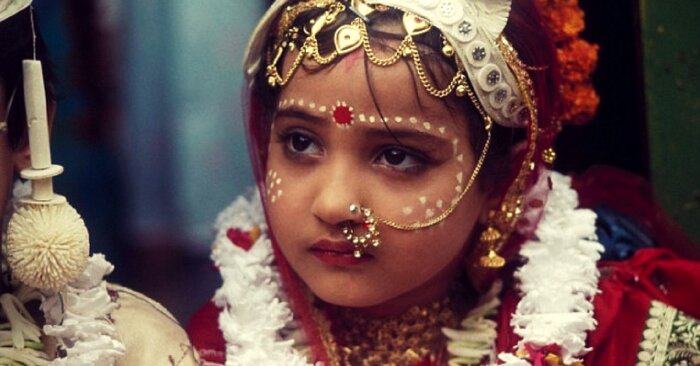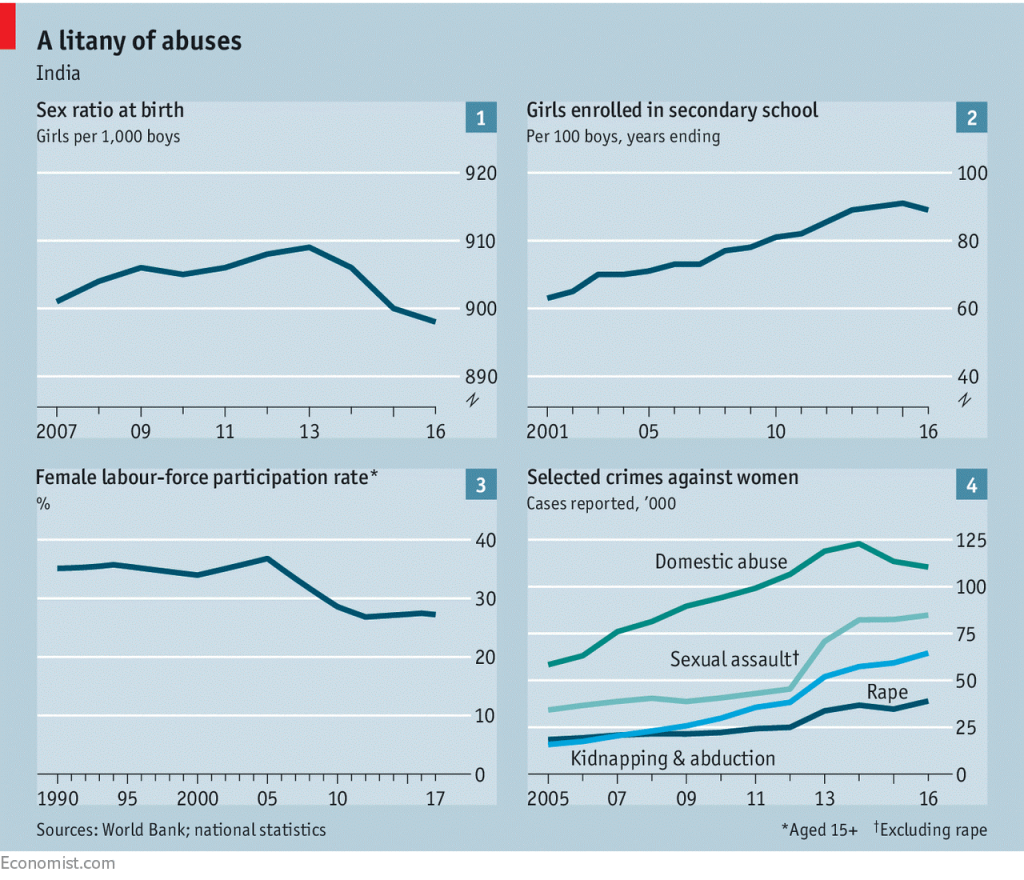By AlignIndia Editors
(Featured Image Courtesy: shethepeople.tv)
The fight for gender equality in India is far from over – yet the government actions indicate otherwise.
Quite the transition: a few years ago, posters promoting gender equality were like the one on the left: they described women’s enormous potential. In the recent poster on the right, a little girl is reduced to someone who makes rotis. It reads: How will you eat the rotis that girls make if you don’t even let them be born?
Fourteen-year-old Saanvi clutches at her red lehenga as her mother brushes her hair. She traces patterns in the rough cotton, listening vaguely to the vibrant music blaring over speakers in the field across the street. The sun is setting; you can see streaks of gold on the path just outside. A group of small boys runs across this path, their raucous laughter drowned out by the relentless music. She watches them play-fighting with their school satchels and sighs. She will never sport one of those satchels again.
Instead, she sports the dress her family has made her after months of saving and borrowing money. It is an exquisite dress, the same garish red her sister’s was a year before. This sister stands across the bare room, smiling wanly as she swaddles her sleeping baby.
At last, her mother steps away. The braid is finished. Her daughter is beautiful.
Today, Saanvi is to be married, and today she is to lose the little freedom childhood had granted her.
Saanvi is far from alone. UNICEF estimates that 27% of girls in India are married under the age of eighteen every year. That’s 15,509,000 child brides a year – the highest number in the world. In many parts of rural India, girls are viewed as paraya dhan – the property of another. The property of their husbands’ families. Their education is neglected, their instruction often limited to household chores. And as they reach their teens, they are married.
Do them Justice
Child marriage is just one of the ways India’s brutal gender inequality manifests itself. Crimes against women are on the rise, and young girls are taught that it is their own fault if they are raped. From sex-selective abortions to unreported abuse, every facet of Indian society reveals a way in which India has betrayed its women.
India is a nation founded on the principle of equality – it is one of the tenets of the Constitution. And in the years following its independence, India progressed by leaps and bounds despite its multitudinous problems. It became one of the first countries to grant women the vote. The female literacy rate rose from 8.86% in 1951 to 65.46% in 2011.
In the present day, though, this progress is dwindling – and there is still a long way to go before Indian women are treated equal to men.
This is in part due to the increase in government apathy toward this issue in recent years. For instance, in the year 2006, Finance Minister P. Chidambaram started a gender budget that designated 4.8% of the national budget for women and children. This figure increased to 5.5% in 2009, but has since stagnated or decreased. The expenditure on women-specific schemes has fallen from a high of 37.72% of this number in 2007-8 to 19.91% in 2020-21. And the results are evident – women’s labor force participation rate (LFPR) has plummeted, shifting from 42.7 percent in 2004-05 to 23.3 percent in 2017–18.
The propagation of bigoted views by the current BJP government has also led to an about-turn in societal opinion on feminism. Prime Minister Modi praised the prime minister of Bangladesh on her move to counteract terrorism ‘despite being a woman’. The chief minister of Haryana commented on ‘bring[ing] girls from Kashmir’ to balance Haryana’s sex ratio, a reflection of his view of women as a commodity. Members of the party have even voiced their support of child marriage.
The outcry for justice of years past has been largely eclipsed by brazen support of patriarchy. In past years, we decried the purdah and fought for female literacy. Today, vigilantes abound, shaming women for wearing jeans and using mobile phones. There is an army of social media trolls dedicated to demeaning women who criticize the regime – based on their gender alone. That is not to say feminism in India is dead: there are vibrant movements gaining momentum nationwide. But these are worryingly few and far between.
A Post-Apocalyptic Future
The government’s declining interest in furthering gender equality is made evident by its actions. This was worrying enough for a country where girls, for the large part, are seen as vessels for producing boys. To make matters worse, the covid-19 pandemic and the resulting school closures will undoubtedly deal a heavy blow to the already-declining share of women in the workforce, as mothers are forced to quit their jobs to care for their children.
All things considered, Indian women’s future appears bleak. In a country where they cannot venture out of their homes at night for fear of being attacked, how can they live and grow as individuals?
Look around in a bustling Delhi street, and you’ll see a single sticker plastered onto countless trucks and rickshaws. Beti bachao, beti padhao, it proclaims. Save a daughter, educate a daughter. A noble sentiment, but little more. India’s women deserve more than empty promises. They deserve the elusive education the sticker promises but never grants.
So, people of India, the time has come to act. Unless we do something now, another thousand little Saanvis will shut their schoolbooks for the final time and prepare for a lifetime of servitude.
Align India helps you dismantle propaganda piece by piece, so you can make sense of the world in these confusing times. We aim to tell you when something’s not right. We work to revive those core Indian values that are being lost to bigotry and jingoism. Above all, we strive to keep Indian democracy alive.
(AlignIndia helps you dismantle propaganda piece-by-piece, so that Indian Democracy stays alive. The deafening din of bigotry and jingoism has made us forget Gandhi, Nehru, Patel, Shastri and scores of other leaders who built India based on the values of peace and ethics, standing up for the downtrodden and the voiceless. Our effort is aimed at reviving these core values as enshrined in the Constitution of India while fiercely protecting the diversity, which defines the idea of India.)



